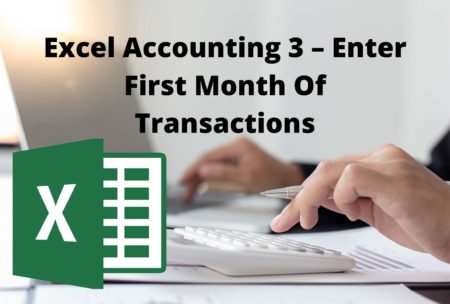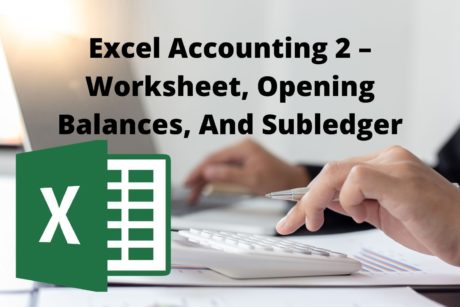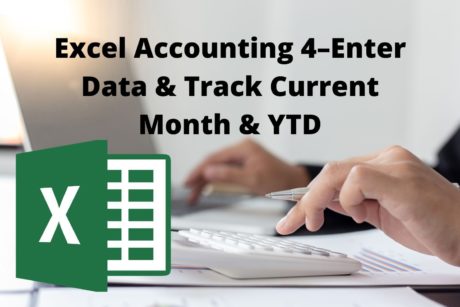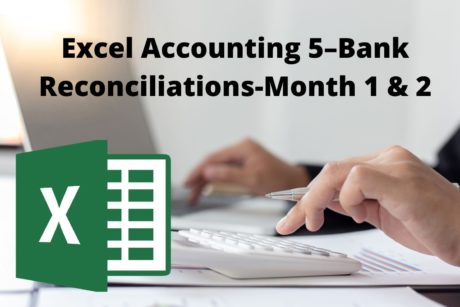Learn how to enter transactions and their impact on the general ledger, subsidiary ledgers, trial balance, and financial statements. Read more.
Robert (Bob) Steele CPA, CGMA, M.S. Tax, CPI
Access all courses in our library for only $9/month with All Access Pass
Get Started with All Access PassBuy Only This CourseAbout This Course
Who this course is for:
- Anybody that wants to learn accounting
- Anybody that wants to learn Excel
- Accounting and business students
What you’ll learn:
- How to record financial transactions into an accounting system using an Excel worksheet
- How to record the impact of each financial transaction on the general ledger, subsidiary ledgers, trial balance, and financial statements
- How to enter financial transactions related to the owner investing in the company and the business taking out a loan
- How to enter transactions related to the purchase of inventory and investing in short term investments
- How to enter transactions related to the selling of inventory
- How to enter transactions related to the receipt of payments from customers
- How and why to use the undeposited funds accounts often seen in accounting software like QuickBooks
- How to enter transactions related to writing checks for common expenses like utilities and phone
- How to enter transactions related to paying employees, including withholdings and employer taxes
- How to create month-end financial statements
Requirements:
- None. If you do not have access to Excel, you may use Google Sheets.
In this course, we will enter common financial transactions for the first month of operations into an accounting system set up using an Excel worksheet.
Learners will learn how to navigate Microsoft Excel as well as how to use a well-designed accounting worksheet, complete with a general journal, trial balance, general ledger, subsidiary ledgers for accounts receivable, accounts payable, inventory, financial statements and much more.
Excel is a very good tool to learn accounting because it is much more transparent than a database program, like accounting software, QuickBooks being a common example of accounting software.
For most new steps in the process, you will have access to a downloadable Excel Workbook, containing at least two tabs, one with the answer, the new steps being completed, the other starting out where the prior presentation left off.
As we enter financial transactions, we will discuss common data input forms used to enter the transactions by accounting software like QuickBooks. We post and analyze the impact of each financial transaction on the general journal, the general ledger, subsidiary ledgers, trial balance, and financial statements.
New businesses often need to generate capital or cash that they can then use to invest in property plants and equipment, inventory, and start-up costs. The first few transactions we will enter will be related to the owner putting personal funding into the business and the business taking out a loan from a financial institution.
We will then consider financial transactions related to the purchase of inventory and the purchase of short-term investments like stocks and bonds.
Learners will know how to enter transactions related to selling inventory items, tracking inventory using a perpetual inventory method, and adjusting the inventory subledger with each sale and purchase of inventory.
The course will discuss the financial transactions related to receiving payments from a customer, decreasing the accounts receivable, tracking the accounts receivable subledger, and recording accounts receivable by the customer.
We will also discuss the use of undeposited funds as a tool to group our deposits in the same way we expect them to show on the bank statement, making the bank reconciliation process – a very important internal control – easy.
The course will demonstrate entering transactions related to writing checks for expenses like utilities and the telephone, and prepaid expenses like insurance.
Learners will also enter transactions related to payroll, requiring us to withhold employee payroll taxes, and enter employer payroll taxes.
After entering a month’s worth of data input, we will create and adjust our financial statements, the balance sheet, and the income statement.
Our Promise to You
By the end of this course, you will have learned how to record financial transactions into an accounting system using Excel.
10 Day Money Back Guarantee. If you are unsatisfied for any reason, simply contact us and we’ll give you a full refund. No questions asked.
Get started today!
Course Curriculum
| Section 1 - Month 1 - Record Owner Investment, Purchase Of Fixed Assets And Inventory | |||
| Excel Accounting 3 – Downloadable Worksheets | 00:00:00 | ||
| 7020 Record Deposits From Owner And Loan | 00:00:00 | ||
| 7040 Purchase Of Furniture And Investment Transactions | 00:00:00 | ||
| Section 2 - Month 1 - Enter Transactions For Purchase Inventory | |||
| 7080 Cash Payment For Inventory Linked To Purchase Order P.O. | 00:00:00 | ||
| Section 3 - Month 1 - Enter Transactions For Sale Of Inventory And Deposits | |||
| 7100 Invoice Selling Inventory | 00:00:00 | ||
| 7120 Receive Payment From Previous Invoice | 00:00:00 | ||
| 7140 Sales Receipt Payment Received At Point Of Sale | 00:00:00 | ||
| 7160 Deposits From Undeposited Funds | 00:00:00 | ||
| Section 4 - Month 1 - Enter Transaction For Sale Of Inventory, Receive Payment And Bill | |||
| 7180 Invoice Created From Check Created From Purchase Order | 00:00:00 | ||
| 7200 Receive Payment And Make Deposit | 00:00:00 | ||
| 7220 Write Checks For Expenses And Prepaid Assets | 00:00:00 | ||
| 7240 Bill Pay | 00:00:00 | ||
| Section 5 - Month 1 - Transactions For Payroll And Create Sales Receipt | |||
| 7280 Pay Employees | 00:00:00 | ||
| 7281 Pay Employees Part 2 | 00:00:00 | ||
| 7300 Enter Billable Time And Add To Invoice | 00:00:00 | ||
| 7301 Enter Billable Expenses To Invoice | 00:00:00 | ||
| Section 6 - Month 1 - Create Financial Statements | |||
| 7320 Month One Financial Statements | 00:00:00 | ||
About This Course
Who this course is for:
- Anybody that wants to learn accounting
- Anybody that wants to learn Excel
- Accounting and business students
What you’ll learn:
- How to record financial transactions into an accounting system using an Excel worksheet
- How to record the impact of each financial transaction on the general ledger, subsidiary ledgers, trial balance, and financial statements
- How to enter financial transactions related to the owner investing in the company and the business taking out a loan
- How to enter transactions related to the purchase of inventory and investing in short term investments
- How to enter transactions related to the selling of inventory
- How to enter transactions related to the receipt of payments from customers
- How and why to use the undeposited funds accounts often seen in accounting software like QuickBooks
- How to enter transactions related to writing checks for common expenses like utilities and phone
- How to enter transactions related to paying employees, including withholdings and employer taxes
- How to create month-end financial statements
Requirements:
- None. If you do not have access to Excel, you may use Google Sheets.
In this course, we will enter common financial transactions for the first month of operations into an accounting system set up using an Excel worksheet.
Learners will learn how to navigate Microsoft Excel as well as how to use a well-designed accounting worksheet, complete with a general journal, trial balance, general ledger, subsidiary ledgers for accounts receivable, accounts payable, inventory, financial statements and much more.
Excel is a very good tool to learn accounting because it is much more transparent than a database program, like accounting software, QuickBooks being a common example of accounting software.
For most new steps in the process, you will have access to a downloadable Excel Workbook, containing at least two tabs, one with the answer, the new steps being completed, the other starting out where the prior presentation left off.
As we enter financial transactions, we will discuss common data input forms used to enter the transactions by accounting software like QuickBooks. We post and analyze the impact of each financial transaction on the general journal, the general ledger, subsidiary ledgers, trial balance, and financial statements.
New businesses often need to generate capital or cash that they can then use to invest in property plants and equipment, inventory, and start-up costs. The first few transactions we will enter will be related to the owner putting personal funding into the business and the business taking out a loan from a financial institution.
We will then consider financial transactions related to the purchase of inventory and the purchase of short-term investments like stocks and bonds.
Learners will know how to enter transactions related to selling inventory items, tracking inventory using a perpetual inventory method, and adjusting the inventory subledger with each sale and purchase of inventory.
The course will discuss the financial transactions related to receiving payments from a customer, decreasing the accounts receivable, tracking the accounts receivable subledger, and recording accounts receivable by the customer.
We will also discuss the use of undeposited funds as a tool to group our deposits in the same way we expect them to show on the bank statement, making the bank reconciliation process – a very important internal control – easy.
The course will demonstrate entering transactions related to writing checks for expenses like utilities and the telephone, and prepaid expenses like insurance.
Learners will also enter transactions related to payroll, requiring us to withhold employee payroll taxes, and enter employer payroll taxes.
After entering a month’s worth of data input, we will create and adjust our financial statements, the balance sheet, and the income statement.
Our Promise to You
By the end of this course, you will have learned how to record financial transactions into an accounting system using Excel.
10 Day Money Back Guarantee. If you are unsatisfied for any reason, simply contact us and we’ll give you a full refund. No questions asked.
Get started today!
Course Curriculum
| Section 1 - Month 1 - Record Owner Investment, Purchase Of Fixed Assets And Inventory | |||
| Excel Accounting 3 – Downloadable Worksheets | 00:00:00 | ||
| 7020 Record Deposits From Owner And Loan | 00:00:00 | ||
| 7040 Purchase Of Furniture And Investment Transactions | 00:00:00 | ||
| Section 2 - Month 1 - Enter Transactions For Purchase Inventory | |||
| 7080 Cash Payment For Inventory Linked To Purchase Order P.O. | 00:00:00 | ||
| Section 3 - Month 1 - Enter Transactions For Sale Of Inventory And Deposits | |||
| 7100 Invoice Selling Inventory | 00:00:00 | ||
| 7120 Receive Payment From Previous Invoice | 00:00:00 | ||
| 7140 Sales Receipt Payment Received At Point Of Sale | 00:00:00 | ||
| 7160 Deposits From Undeposited Funds | 00:00:00 | ||
| Section 4 - Month 1 - Enter Transaction For Sale Of Inventory, Receive Payment And Bill | |||
| 7180 Invoice Created From Check Created From Purchase Order | 00:00:00 | ||
| 7200 Receive Payment And Make Deposit | 00:00:00 | ||
| 7220 Write Checks For Expenses And Prepaid Assets | 00:00:00 | ||
| 7240 Bill Pay | 00:00:00 | ||
| Section 5 - Month 1 - Transactions For Payroll And Create Sales Receipt | |||
| 7280 Pay Employees | 00:00:00 | ||
| 7281 Pay Employees Part 2 | 00:00:00 | ||
| 7300 Enter Billable Time And Add To Invoice | 00:00:00 | ||
| 7301 Enter Billable Expenses To Invoice | 00:00:00 | ||
| Section 6 - Month 1 - Create Financial Statements | |||
| 7320 Month One Financial Statements | 00:00:00 | ||




